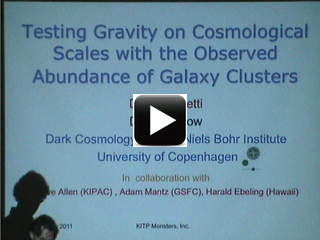Using observations of the abundance of massive, X-ray flux-selected galaxy clusters, we obtain tight constraints on both the growth and expansion histories of the Universe. Our data set consists of 238 clusters detected by the ROSAT All-Sky Survey, and incorporates follow-up observations of 94 of those clusters using the Chandra X-ray Observatory and/or ROSAT. Using a new statistical framework that self-consistently produces simultaneous constraints on cosmology and observable-mass scaling relations, we account for survey biases, parameter degeneracies and the impact of systematic uncertainties, and obtain improved constraints on departures from General Relativity (GR) on cosmological scales. We parameterize the linear growth rate of cosmic structure with a power law of the mean matter density to the growth index. Combining the X-ray cluster growth data with cluster gas-mass fraction, type Ia supernovae, baryon acoustic oscillations, and cosmic microwave background data we find a tight correlation between the growth index and the normalization of the matter power spectrum. Allowing the growth index and the dark energy equation of state parameter to take any constant values, we find no evidence for departures from the standard paradigm, GR+LCDM. If time permits, I will also present preliminary, new results on testing a well-studied alternative model to GR using our cluster growth data. Our results highlight the power of X-ray cluster studies to constrain cosmology.
 Other video options
Other video options
To begin viewing slides, click on the first slide below. (Or, view as pdf.)
![[01]](tn/01.jpg)
![[02]](tn/02.jpg)
![[03]](tn/03.jpg)
![[04]](tn/04.gif)
![[05]](tn/05.jpg)
![[06]](tn/06.jpg)
![[07]](tn/07.jpg)
![[08]](tn/08.jpg)
![[09]](tn/09.jpg)
![[10]](tn/10.jpg)
![[11]](tn/11.gif)
![[12]](tn/12.gif)
![[13]](tn/13.jpg)
![[14]](tn/14.jpg)
![[15]](tn/15.jpg)
![[16]](tn/16.jpg)
![[17]](tn/17.jpg)
![[18]](tn/18.jpg)